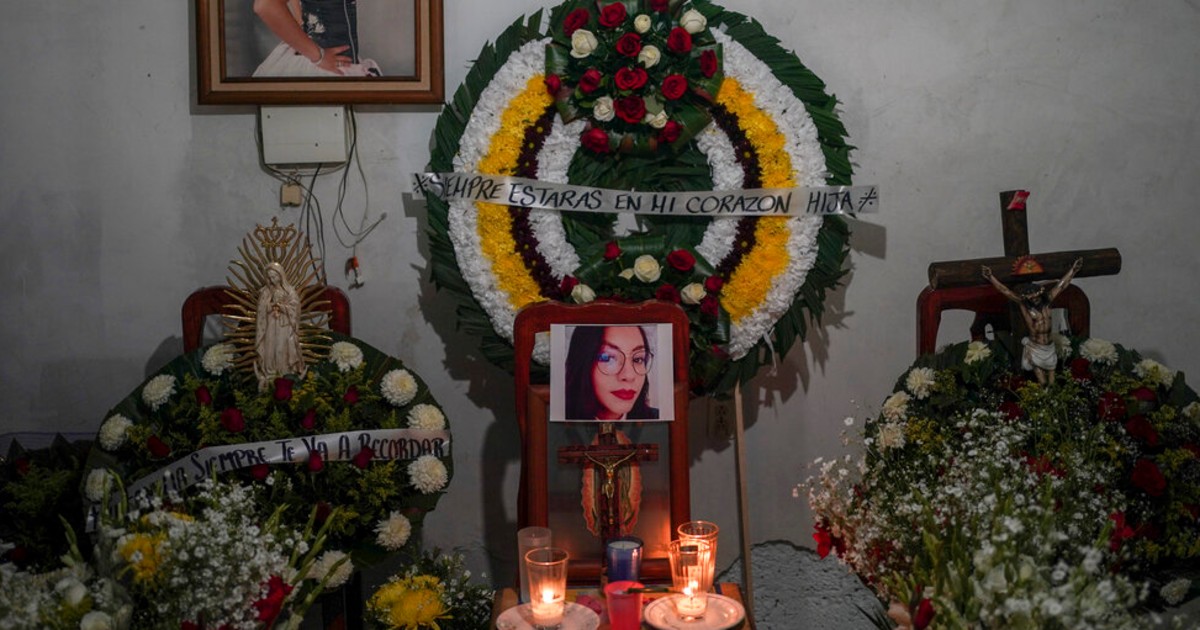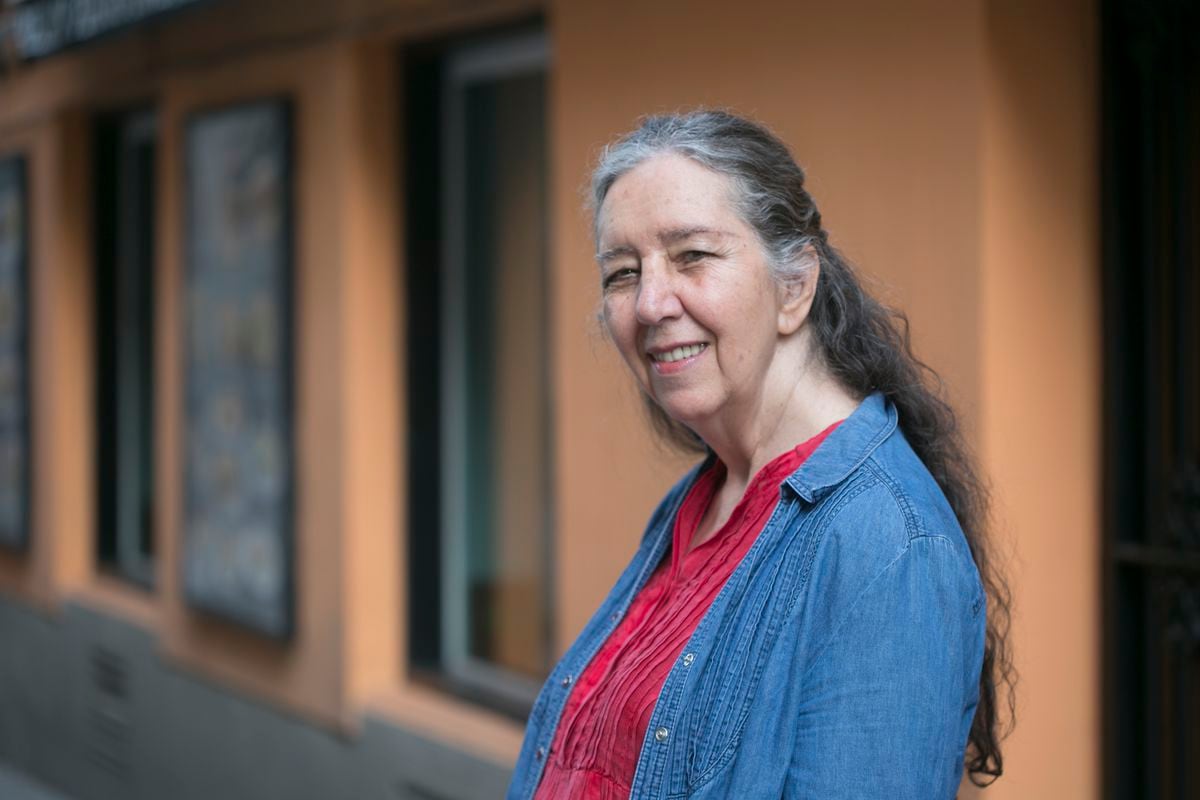By Fabiola Sánchez and Fernanda Pesce -
The Associated Press
One November afternoon, Mónica Citlalli Díaz left her home in a crowded town on the outskirts of the Mexican capital to go to the school where she taught English.
She didn't come to work.
His absence immediately alerted his family and colleagues who papered the walls of the town of Ecatepec with flyers bearing his photograph.
After four days with no sign of Díaz, 30, his relatives blocked the street in front of the school to demand action from authorities.
Two days later his body was found in the brush next to a road.
Photographs of Mónica Citlalli Díaz are shown during her wake at her home in San Salvador Atenco, State of Mexico, Mexico, Thursday, November 10, 2022. AP
Women in Mexico are dying at a terrifying rate: from January to November there were 131 femicides and 241 homicides in the State of Mexico alone —which surrounds the capital— and last year throughout the country there were more than 1,000 femicides and homicides. fraudulent
The figure is only surpassed by Brazil in Latin America.
Experts and human rights advocates argue that gender-based violence can be attributed to deeply entrenched cultural machismo and systemic inequality, as well as a system plagued with problems: police who won't take complaints about missing women, blundering investigations, and prosecutors and judges who revictimize women.
There are so many cases that most receive little attention.
But protests by Díaz's family put pressure on authorities and grabbed headlines.
Three days after her disappearance, the president of the Supreme Court of Justice of the Nation, Arturo Zaldívar, called for a national protocol to deal with femicides and said that all homicides of women should be investigated as such.
The next day, at his daily press conference, President Andrés Manuel López Obrador said that he agreed with the proposal.
What happened to Debanhi Escobar?
These are the keys to the case that is shocking Mexico
April 29, 202202:47
Some states have tried to address the problem by creating prosecutors for gender crimes.
For its part, the federal government has declared more than two dozen alerts for gender violence since 2015 at the request of civil society groups.
These alerts oblige local, state and federal authorities to take coordinated emergency measures and guarantee security, prevention and access to justice.
But the authorities themselves have recognized that the benefits of alerts and other measures have been limited.
“I saw the cases of femicide on television and always said 'poor women, poor families, poor children,'” recalled Massiel Olvera, Díaz's older sister.
"The horrible way in which they violated their bodies, the atrocious way in which they hurt them, how they left them."
When photos of the last victim found began to circulate, his phone vibrated.
Her face was not visible, but Olvera recognized her sister's pants, her shoes, and her hands.
"They left it thrown from her like a garbage bag."
["You can no longer go out without fear", they protest in Mexico against femicides]
Following the murders of hundreds of women and girls in the northern state of Chihuahua, which borders the United States, in the late 1990s and early 2000s, the Lower House of the Mexican Congress created a special commission to study femicide that in 2006 it issued a report that concluded that accurate data was nearly impossible to obtain because some states did not even provide a gender breakdown of victims.
Vanessa Guillén's mother requests life imprisonment for the accused of disposing of the remains of the soldier
Nov 30, 202202:12
As a result of the commission's work, in 2007 the General Law on Women's Access to a Life Free of Violence was approved, which created gender violence alerts.
In 2010, legislators added femicide—defined as the violent death of a woman for gender reasons—to the federal penal code, and the following year the State of Mexico established its gender-based crime prosecutor's office.
Despite the efforts, last year there were more than double the number of femicides in the country than in 2015, according to federal data.
Impunidad Cero, a non-governmental organization that studies the high rate of impunity in Mexico's justice system, said in its report this month that the national femicide rate in 2021 was 1.55 per 100,000 women, up 125%. than six years before.
Some authorities have attributed this to greater awareness of the issue and the willingness to classify more cases as such, but Zero Impunity also found that in 2021 only 27% of violent deaths of women were classified as femicides.
Gender-based violence
"persists as a reality and there are no clear signs that the phenomenon is diminishing
," said a recent report by the Gender Equality Observatory for Latin America and the Caribbean, which depends on the Economic Commission for Latin America and the Caribbean. (ECLAC).
[This Mexican woman traveled to another country for love and ended up dead and desecrated on a beach. The alleged murderer of her feels "humiliated"]
María de la Luz Estrada, coordinator of the National Citizen Femicide Observatory of Mexico, attributed responsibility for errors in the investigations, which range from the inadequate preservation of crime scenes to corruption among local and state police, which in some cases cases collude with criminals.
“The problem is a total breakdown of a collapsed justice system,” Estrada said.
Dilcya García, who directs the prosecutor's office for the attention of crimes related to gender violence in the State of Mexico, affirmed that the problem is part of the social structure.
"Violence against women is very complex to address and very complex to eradicate... Sociocultural patterns, those behaviors learned, are generating and on many occasions, even demanding violence against women."
The day after Díaz's family blocked the street in Ecatepec, García sat down with them.
She told them that she was committed to finding her but she raised the possibility that she was not alive.
It was she herself who later called Olvera to tell her that they had found the body of her sister.
The case of Diana Velázquez has become an emblem of dysfunction in femicide investigations in Mexico.
They reveal new details of the murder of Ariadna Fernández: some friends would have killed her
Nov 7, 202203:52
Velázquez, a 24-year-old candy vendor, was murdered in Chimalhuacán, east of Mexico City, in 2017. She left her home early one morning to make a phone call, and her body was later found dumped in front of a slaughterhouse. of chickens.
She had been beaten, raped and strangled.
Among other errors in the investigation into her death, Velázquez was initially identified by the authorities as a man, for which her family took days to locate her in the morgue and when they finally did, they discovered that the body had been in a patio, so that the degree of decomposition was advanced.
In addition, during the investigation, her clothing was lost, which could have been essential in the collection of genetic material to identify her murderer.
After three years without progress in the process, Lidia Florencio Guerrero, Diana's mother, held a sit-in in front of the presidential palace in July 2020 to demand justice.
Days after that protest, the Prosecutor's Office announced that a motorcycle taxi driver had been arrested for the murder who, according to the authorities, was linked to the process after tracking the calls from the young woman's mobile phone and the testimony of the detainee's partner, who he had in his possession Velázquez's telephone number and that, when denouncing him for domestic violence, he assured that he had confessed to the crime.
The detainee was sentenced in January to 93 years in prison for femicide and after appealing he managed to have his sentence reduced by almost 30 years, a decision that is under review after an appeal filed by the young woman's family.
Because the investigation was so flawed, and a second suspect was never arrested, Florencio Guerrero harbors doubts.
"This entire justice system is still a long way from delivering the truth to us," said her mother, complaining that prosecutors, police officers and experts "are still there doing a bad job and the corresponding authorities do not sanction them."
Díaz's family hopes for a different result and that the process does not drag on.
The young woman had a job that she liked and was dedicated to her 11-year-old daughter Keila.
The teacher had already had her struggles: she became a mother at 19 and she left the girl's father after episodes of domestic violence.
According to her sister, on one occasion their mother hit her son-in-law with a stone to make him stop attacking her daughter.
After separating from Keila's father, Díaz returned to live with her parents in a modest house.
The Mexican Prosecutor's Office recovers the weapon used to assassinate the singer Yrma Lydya
June 25, 202200:23
This year she had met Jesús Alexis Álvarez Ortiz, an athletic 27-year-old who worked in a hotel in Mexico City, in a gym.
He was possessive, Olvera acknowledged, adding that after they started dating him, her sister lost so much weight that her eyes turned yellow.
She sometimes she didn't get home until midnight or the next morning.
Even so, Diaz never missed work.
He left every morning at 6 and returned to his house at noon to have lunch with Keila and rest before returning for a second session of classes until the evening.
On the afternoon of November 3, when she disappeared, her father received a strange text message on his phone.
"Hey, a friend is going to let me live for a few months in her house in Hidalgo," he said.
He didn't mention her work or Keila.
Her family began calling her on the phone, but could not reach her.
That night her boyfriend showed up at her house asking for her.
Álvarez Ortiz seemed nervous, stuttered and began to say that the teacher used drugs, that she was depressed and that a stranger called her at night to threaten her, Olvera recalled.
The young man accompanied the family to report the disappearance but two days later he stopped answering his phone and his mother reported him missing.
According to authorities, after leaving his home that afternoon, Díaz took a taxi to a shopping center and then another to Álvarez Ortiz's house.
Video from street security cameras showed the teacher entering the house, which she never left.
Hours later a van arrived and left.
Authorities believe he was carrying Diaz's body.
After a search of the house, Díaz's blood-stained clothes were found.
Three days after the discovery of the body, the police arrested Álvarez Ortiz.
The death of television presenter Michelle Simon in Mexico is being investigated as a femicide
Feb 23, 202201:44
The autopsy indicated that the young woman had died of a severe blow to the head.
Álvarez Ortiz has been jailed accused of forced disappearance.
Díaz's family hopes that in a forthcoming hearing, scheduled for March, the prosecutors will add the charge of femicide after they have collected all the evidence against him and the protocols for the imputation have been completed.
The Associated Press tried to contact Álvarez Ortiz's lawyers for a reaction but was unable to do so.
"If the authorities do not give me a favorable response, I am going to go out into the street to close the avenue," Olvera said.
"I'm going to stop until they listen to me and justice is done."




/cloudfront-eu-central-1.images.arcpublishing.com/prisa/PGFLWZYGBFG7FBITHUY7ILSNBQ.jpg)








/cloudfront-eu-central-1.images.arcpublishing.com/prisa/KMEYMJKESBAZBE4MRBAM4TGHIQ.jpg)

